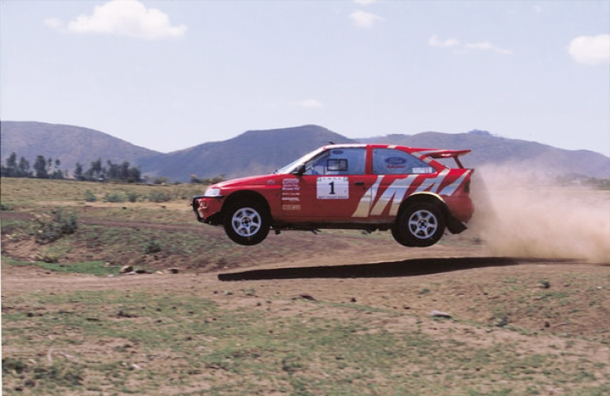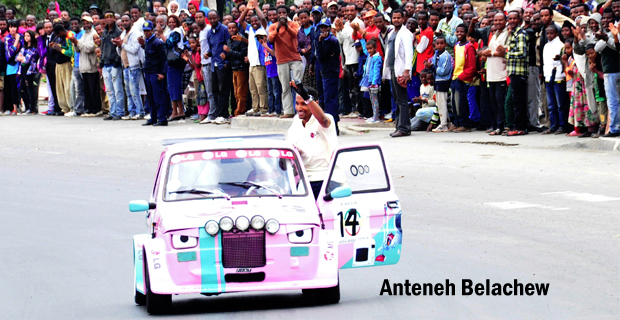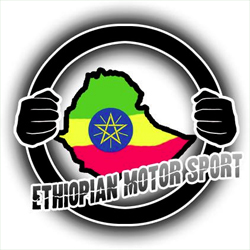For the love of the race

Addis Ababa, Ethiopia – From its glory days in the 1960s, Ethiopian motorsport suffered under the Derg to the point of extinction.
Gradually gaining strength with the new government of the early 90s, for many enthusiasts the thrill of race day is without comparison, and there is a concerted effort to revive this iconic pursuit, to once again hold races that would be the envy of the East African region, writes Tibebeselassie Tigabu.
‘When the going gets tough, the tough get going’, seems to be the motto of car racers. The speed gets them, the risks haunt them, and the smell of an engine creates a different meaning to their life.
The famous driver Ernesto Molinari was born and raised in Ethiopia, and runs, drives motorbikes or does anything to fulfill his need for speed. “Adrenaline cannot be forgotten and is like a drug,†he says.
His father, John Franco Molinari, was one of the drivers from the “golden age†of Ethiopian racing in the 60s and 70s. For Ernesto it is not only continuing the family legacy, but also the community. “Italians love cars,†he says, and it is natural for him.
His parents are from what is known as “the triangle of motor sportâ€, an area which produces the three Italian supercars: Lamborghini, Ferrari and Maserati, so he grew up with that love and passion.
After watching his father racing he embarked on a motorsport career aged 18 after gaining his driving license. Initially he did not drive a racecar, rather a slightly modified 1000cc Renault 5, and his first competition was a short rally, 400 kms to Zequala Mountain. After that there was no stopping him, and he has lost count of the number of races he has driven in. Being a speed fanatic he likes the faster races, with higher engine performance, which present more of a challenge. “I have always been into speed,†he says.
During the reign of Emperor Haile-Selassie I the highland rally used to cover 5,000kms, but it gradually reduced to 3,000kms and is currently 1,500kms, covering a different route every year and taking a couple of days to complete. Ernesto had a co-driver for more than ten years, but four years ago he retired after many good memories. However it seems that once you are in the game there is no way out, and the co-driver is coming out of retirement for the upcoming highland rally in March.
In the past he used to train but now he also has to fit in his engineering work, so only practices in the lead up to competitions. Racing is a way of life for him, he knows cars inside and out, always working on engine upgrades and changing parts.
Since 1992 he has only used two cars, and was able to import a specialized racecar in 1998 at a cost of 180,000 birr.
Modifications are a natural part of the racing process, but it became harder when duty free privileges were banned, leading to a dependence on old car parts, both a blessing and a curse. The ban came about as some drivers were seen to be abusing the laws, importing cars and moving them on illegally.
As the cars are especially designed for racing, with safety equipment and particular engines, they are expensive on the market, so the racers concentrate on updating older models. In other countries drivers have access to an array of expensive racecars, sponsored by large companies such as Toyota, Mitsubishi, Citroen, Peugeot, Porsche or BMW. And a Formula One car can cost in excess of USD two million, but in Ethiopia the experience is different.
According to Ernesto the young drivers start by buying scrap cars and slowly transform them into racecars; it is a passion he loves.
Even though many are scared off as they think it is an expensive sport, he says you only need the safety equipment to convert a normal car, which can cost around 20,000 birr. Attitudes vary, and some spend a lot of money upgrading old cars, while others outlay great sums on new cars.
If you have the money then you can start big, but Ernesto points to the different engine categories that give a chance for everyone.
“We all started that way. I didn’t have the money to spend on a special car, I used a normal car,†he says.
The rally is not an easy race, rather it needs determination, persistence and endurance, and there is also the risk of injuries. Ernesto has had a couple of accidents, the most serious in a test drive after hitting a dog and crashing into a wall.
He was hospitalized for ten days and broke his nose, but after five days he was eager to get back into the seat. All the rallies and competitions are for the passionate only; Ernesto knows it is not possible to do as a career.
Drivers face many challenges, and there was a time when he lost all hope with the racing federation. Racecars, spare parts and the super benzene (AVIO) fuel required are not available in Ethiopia, and there are only limited fans.
Drivers struggle to keep the sport alive and face mounting costs, and still have to pay an entrance fee to be part of the races. The Shell Oil company used to supply AVIO, but since it left they rely on additives from South Africa to convert the local fuel into race fuel, or import from Kenya.
Against all the odds the drivers make it to race day, and Ernesto cannot wait for the green light to start the race. Although nervous beforehand, once in the race he becomes calm.
Attending school in Italy he was able to see how the big car races are done, with all the money and sponsorship, and as he did not have the finances was forced into lower profile competitions. It was not only in Europe that he suffered, and has never competed in the famous Kenya safari or Dakar rallies because of a lack of financial muscle or rich benefactor. Aside from that many of the cars in Ethiopia are old and not competitive by international standards. He says there are many excellent car racers here, but because of the numerous obstacles they cannot compete in the international competitions. He strongly believes competitors should be invited from neighboring countries, and that local drivers should be able to enter the African Championships. With the new “dynamic team†of the federation board, which became a member of the Federation Internationale de l’Automobile (FIA), he believes there is hope for the future and the sport will take the place it deserves.
It is not only Ernesto who is striving to see the sport grow. Simone Ferrari, 38, also followed in the footsteps of his racer father. His love for cars started at a young age, and even though his father stopped racing when he was born he taught him how to drive as soon as he was old enough. When he was six he would sit on his father’s lap and attempt to drive, and by 11 he had mastered the skill.
When he started racing at the age of 19 it was in a 1300 cc Renault 12, and after initial frustration he started to win when he changed cars. He has been racing for half his life, and has had four cars, including a 1.6 Toyota Corolla and his current drive, a 1992 1.9 Peugeot 205.
With the expensive nature of the sport in Ethiopia he spent 500,000 birr on his first car, 100,000 to purchase and the rest to upgrade. His dream car is a Mitsubishi Lancer 10, 2010 model, which costs 40,000 euro, however it is out of his price range so he prefers to buy used cars.
His Peugeot cost 140,000 birr and was already fitted as a racecar, albeit an old one. According to him it is difficult to find racing cars, and there are only a few mechanics capable of building cars, while imported spare parts are liable for high tax rates.
After more than 60 races and many victories it is the highland rally that really captures Simone’s attention. “It is because of the adventure and also the endurance, navigation; it has many sides to it,†he says. It is not only cars, he also races motorbikes. “I love the engines, the speed, the challenge of competitions.†Comparing the two he says that cars are safer, and with motorbikes he has had a couple of injuries, although none were serious. “Sometimes you don’t really think of the risks.â€
A software engineer by profession, Simone has traveled to watch rallies in Kenya and Italy, and maintains hope that the local racing will go to that higher level. The rules to be in the international races are tighter, requiring specific cars and special racing licenses, which are not easy to obtain. Always working towards the “glory daysâ€, he highlights the need for more races and ways to attract the younger generation. He holds on to a desire to complete the Kenyan rally by motorbike, and the Dakar race by car.
This sport was once famous during the reign of Emperor Haile-Selassie I, and although most of the participants were Italian, many nationalities such as Swiss, Indians, Norwegians, and Germans took part, along with members of other African countries, all coming to Ethiopia for the highland rally. It is known as the ‘golden age’, and attracted the likes of Tony Fall, the successful British racer who recently passed away.
In those days it was common for more than 50 entrants in any particular race, and many large companies forwarded sponsorship, leading to large prize funds. After a couple of races the cars were available for the public to buy, with the government highly involved, and the nephew of the emperor was one of the patrons .
During that era it was one of the most famous rallies, more well known than the Kenyan Safari rally, but when the Derg took power in 1974 the sport suffered for many years. When current ruling party the Ethiopian peoples’ Revolutionary Democratic Front (EPRDF) assumed control it slowly began to take off again, but has seen the Kenyan rally become the most popular in the region, bringing in millions of dollars and countless tourists. According to Ernesto Ethiopian rallies have huge potential, not only for the sake of the sport but also for tourism. “I hope one day to see it with my own eyes,†he says.
The revival has attracted competitors such as Dawit Teshome, 45, who spends much of his time with cars in his workshop around the Sarbet area.
His passion for racing came about while working as a technician, and a friend told him about a race and even contributed some money for him to take part. He did not own a car, so rented a Fiat Regatta 1600cc, modifying to fit race regulations without telling the owners. Technical problems in the middle of the race meant he could not continue, and looking back now his preparations were a “jokeâ€, led only by passion.
He started studying cars and how they could be modified, details such as engine preparation, compression ratio, and installing special shock absorbers. Before buying a car he was sponsored by the Master Garage in a rally, but the engine failed. This led to a first purchase, a1993 BMW costing 16,000 birr, moving on to an Alpina that cost 27,000 birr, and it was then he started to achieve results. Recently he bought a new Yaris from Germany, and aided by sponsors it cost 6,500 euros duty free, and a subsequent 250,000 birr to transform it into a racecar.

He races for the love, not for the money, and has participated in many rallies, day and night, covering thousands of kilometers. Accidents are part of the race, he says, mentioning the occasion when Roberto Sanji, from Djibouti, killed a child and paid the insurance. Dawit once killed a donkey, with the federation paying compensation, but he shrugs it is just part of racing. When in the car he goes into a trance, and this feeling even translates onto the roads of Addis, where he hates waiting in traffic. For him the constant upgrading and working on cars is a way of life.
He knows there is no money in the sport, but it has helped him network and advertise his workshop. With the sponsors in other countries he is aware of the wealth available, with drivers such as Michael Schumacher owning a training field in his house. He feels that for the sport to pick up companies like MOENCO, Nyala motors and Peugeot need to get involved, encouraging the younger racers to take part. In the past they used to close roads a week before races to help with the preparation, but now things are different. He does not train; rather before the race they check the route for a couple of hours. The passion has passed to his children, and he glances towards his youngest, at two years and eight months old perhaps unaware, for now.
A pastime once dominated by the Italian community is now a place for Ethiopians, not only Dawit but also Anteneh Belachew, who started racing seven years ago. His passion came from watching the city race on the Meskel road, and his first car was a Baby Fiat 126, 1960 model, costing 4,500 birr, and an additional 70,000 birr to modify. His automotive knowledge keeps him upgrading, taking engines from other cars
He won his first competition in Nazreth at 1000cc, and has been regularly winning for the past seven years. Even after going up to 1300cc he kept winning, yet continues to modify and upgrade. He avoids the expensive or dangerous events, considering his family in the decision. Even with the city circuit he spends up to 10,000 birr, and counts himself fortunate to have never had an accident. As a driver for the African Union he drives slowly when he is working, and in his spare time shares his passion with friends, who talk only about cars. He dreams to one day own a Formula One car, even if it does not work.
 With all the challenges the Ethiopian Motorsport Association is working to improve the situation. Board member and president of the association, Ermias Ayele, says the last four years have been a challenging time for the sport, yet with a new board they are trying to promote and popularize.
With all the challenges the Ethiopian Motorsport Association is working to improve the situation. Board member and president of the association, Ermias Ayele, says the last four years have been a challenging time for the sport, yet with a new board they are trying to promote and popularize.
There are limitations in marketing and sponsorship, and this has now been subcontracted to a different company. The first event for the new board is in Janmeda, a city circuit, with the rally following in March. The board members are volunteers, with any money coming from the contribution of corporate members or drivers.
Apart from finding sponsors the association is working on duty free privileges, to help import new cars, the availability of the AVIO fuel, and also event promotion. Most of the cars are at least ten years old, and even those imported duty free cannot be sold on. And even though AVIO is imported from Kenya, it is still not widely accessible. Ermias is hopeful that the sport will continue to grow, with the arrival of new sponsors and a burgeoning relationship with the FIA.
Source: thereporterethiopia.com
Ethiopian Motosport related sites:



